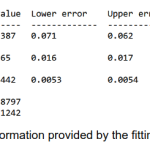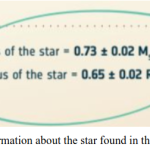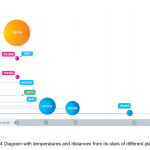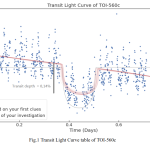
Project Gallery 2023
Secondary students from across Europe became exoplanet detectives with ESA and used Cheops satellite data to uncover the mysteries of two exoplanet targets: KELT-3b and TOI-560c.
Explore the projects below.
JOVAAS
Best Project Prize Winner
Sabadell Astronomical Society Sabadell – Catalonia Spain 18 years old, 17 years old, 16 years old 4 / 1
TOI-560c
TOI-560c project description:
As part of the Hack an Exoplanet Hackathon, we have analyzed data provided by ESA to investigate the exoplanet TOI-560c. Through the analysis of fitted transit light curves provided by the CHEOPS Telescope, we have found that TOI-560c has a radius of 2.66 times the Earth and a mass of 9.70 Earth masses. This reveals that this exoplanet is of type super-Earth. Moreover, we obtained an orbital period of 18.88 days through an automated fit of the transit light curve, facilitated by Allesfitter software. Subsequently, we have utilized Kepler’s third law to calculate the distance between TOI-560c and its host star. Our results indicate a distance of 0.125 AU, which indicates that the possibility of finding liquid water on its surface is very low, given its hot temperatures of about 225ºC. Finally, we calculated the planet’s density by means of the density formula. This allowed us to estimate that TOI-560c has a density of approximately 3.89 g/cm^3. This density determination indicates that the planet is slightly lighter than Mars but denser than the gas giants present in our own solar system. Because of the values we have obtained for the density of TOI-560c, we speculate that it is composed of rocky materials such as iron or carbon.
TOI-560c Results and Analysis
With all the data provided, our team successfully solved the Toi-560c mystery. First of all we fitted the provided transit light curve in Allesfitter in order to obtain information about the star and the planet. After getting the data from Allesfitter we started the analysis of the results.
Size
The first thing we did was calculate the Planet radius, following the next formula:
Transit depth (%) = (π R_planet^2) / (π R_star^2) * 100
We found the transit depth in the graphic provided by Allesfitter. We picked up 0,14% as transit depth value.
Fig.1 Transit Light Curve table of TOI-560c
We isolated the planet radius in the following way:
R_TOI-560c = √ (Transit depth (%) * R_star^2 / 100) = √ (0.14 * (0.65 * R_sun)^2 / 100)= √ (0.14 * (4.53792 x 10^8 m)^2 / 100)
After the substitution, we reached the following results:
R_TOI-560c = √ (0.14 * (4.53792 x 10^8 m)^2 / 100) = 1.697934189… x 10^7 m ≈ 2.66 R_earth
With those results we concluded that TOI-560c is a super-Earth because its radius is more or less twice larger than the Earth radius.
Orbital period and Distance
We can find the value of the orbital period in a table provided by Allesfitter and we need to convert days into seconds.
Fig.2 Table with information provided by the fitting in Allesfitter.
T = 18.8797 days = 1.6312 x 10^6 s
We need to use the star’s mass in this formula and it must be in kilograms, too. We can find the mass of the star in the case file.
Fig.3 Information about the star found in the case file
M = 0.73 * M_sun = 1.4515 x 10^30 kg
The next step was to calculate the distance to its star. In order to solve that problem we used the Kepler’s 3rd Law:
T^2 = (4π^2 / GM) * d^3
Then we isolated the distance from the formula:
d^3 = T^2 * (GM / 4π^2)
Once we changed these units, we substitute the values and achieved the next result:
d = [ (1.6312 x 10^6 K)^2 * (6.6743 x 10^(-11) m^3 / (kg s^2) * 1.4515 x 10^30 kg / 4π^2 ]^(1/3) = 1.8690 x 10^10 m ≈ 0.125 AU
With this information, we concluded that this planet is potentially uninhabitable because of its short distance from its star. This distance involves really hot temperatures and a very low possibility of finding liquid water.
Temperature and Habitability
As we can see in this diagram, TOI-560c has temperatures above 200ºC. In the case file, it is written that the temperature is more or less 225ºC.
Fig.4 Diagram with temperatures and distances from its stars of different planets found in the Step 4 video.
This temperature can be caused by its proximity to its star, being only at 0.125 AU, as we calculated before. That’s why we consider this planet uninhabitable, because its extreme heat makes the existence of liquid water very difficult and we couldn’t resist the heat and the radiation emitted by the star at this distance.
Density and Composition
The last thing we had to check was the density and the composition of the star.
First of all, we had the density formula:
ρ = MV
Then, we substitute the mass by the planet’s mass and the volume by the planet’s volume.
ρ_planet = M_planet / (4πR_planet^3 / 3) = 9.70*M_earth / (4π (1.697934189 x 10^7 m) / 3) = 3.89281 x 10^3 kg / m^3
ρ_TOI-560c = 3.89281 g / cm^3
We can see TOI-560c’s density is a little lighter than Mars’ density, being this second of 3.93 g/cm3.
As the case file says, we suppose TOI-560c is a mini-Neptune or super-Earth, but we can’t confirm its composition. Although, if we look at the composition of this type of planet, we can expect TOI-560c to be a rocky planet, mainly formed by silicon and oxygen. These elements may be accompanied by others, including aluminium, iron, magnesium or calcium.
TOI-560c Conclusions
To conclude, we can affirm that TOI-560c is not habitable for us due to its hot temperature, probably caused by the short distance to its star. Its orbital period is a lot faster than Mercury’s, and its density is a little lower than Mars’. It has a radius of nearly two and a half times the terrestrial radius with a mass of nearly half of Neptune’s mass. We can’t know exactly its composition, it seems it’s a mini-Neptune-sized planet, but we deduce it’s basically formed by rocks, as rocks typically have a density of 2.5 ∼ 3 g / cm^3, so we suppose that it’s composed of rocks and a small metallic nucleus until data on the composition may be obtained.
Supporting files:






